MXA RETRO TEST: IS THIS THE TWO-STROKE THAT COULD BE BEATING THE FOUR-STROKES TODAY?
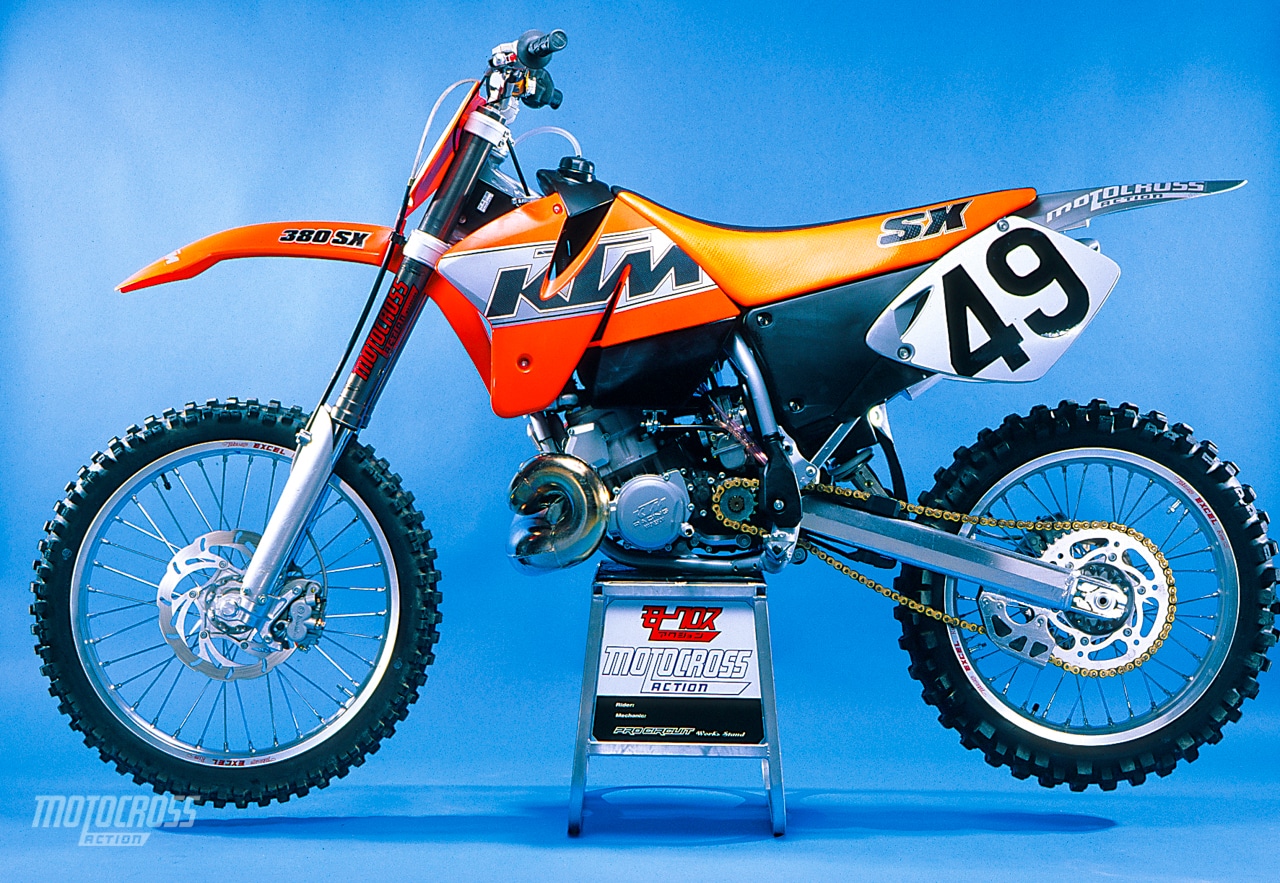 What’s this? A mid-sized two-stroke—sort of like the KTM 350SXF, except as a smoker and twenty-three years ago. Would it fly today?
What’s this? A mid-sized two-stroke—sort of like the KTM 350SXF, except as a smoker and twenty-three years ago. Would it fly today?
We get misty-eyed sometimes thinking about past bikes we loved, as well as ones that should remain forgotten. We take you on a trip down memory lane with bike tests that got filed away and disregarded in the MXA archives. We reminisce on a piece of moto history that has been resurrected. Here is our test of the 2000 KTM 380SX archived from the September 1999 issue of Motocross Action Magazine. Get your MXA subscription today..
IS THE 2000 380 ENGINE FASTER THAN THE ‘99? Yes and no, but mostly no. For 2000, KTM tried to give the mid-sized ‘crosser a torquier feel, less of a 250-style hit and a broader powerband. They succeeded, but for the MXA wrecking crew the whole concept was a failure. The thing we liked most about the ‘99 380SX was that it felt like a 250, hit like a 250 and could be utilized like a 250. No more. The 2000-model has a more enduro-ish style of power. This is not necessarily bad (and for KTM’s core market, which doesn’t include that many motocrossers, it is probably a plus).
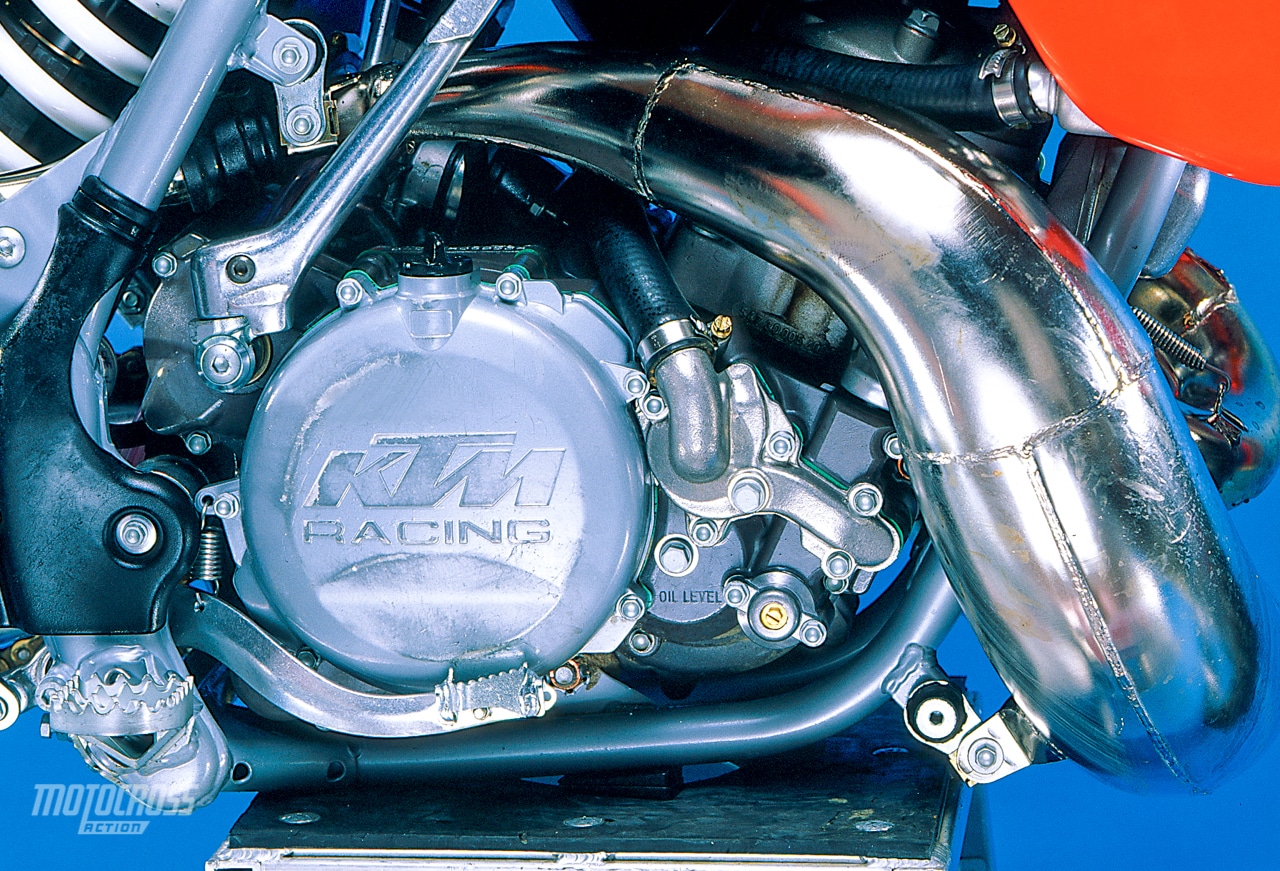 Once we changed the jetting, shortened the silencer, calibrated the timing and changed the gearing we had the 2000 KTM 380 running almost as well as the ‘99. No shame in that, the ‘99 KTM was an awesome Open bike.
Once we changed the jetting, shortened the silencer, calibrated the timing and changed the gearing we had the 2000 KTM 380 running almost as well as the ‘99. No shame in that, the ‘99 KTM was an awesome Open bike.
KTM is plowing virgin ground with the 380. It is the only mid-sized, two-stroke, motocross bike made. The Japanese manufacturers have chosen to either hang on to their ancient mariner 500cc two-strokes or go four-stroke in mid-sized displacement (what is mid-size? Anything smaller than 500 but larger than 300).
WHAT DID KTM DO TO THE ‘99 ENGINE? Cubic centimeters have a way filling in holes in R&D projects. Last year, the 380, which replaced the 360, which replaced the 350, which replaced the 300 (although the three-ought-ought is still available) was a blank sheet of paper design. For 2000, the KTM engineers have started to write on the pages. Here is a quick list of improvements to the 380 engine:
(1) The bore and stroke, porting, cylinder and head are unchanged for 2000, but the engine cases were redesigned. The new cases feature reduced crankcase volume for more fuel velocity via the transfers, realignment of the reed cage to make it square with the crankshaft (instead of tilted), strengthened webbing around the kickstart boss, and less volume in the reed cage inlet tract.
(2) Eschewing a Power Jet carb, KTM still went high-tech with a 38mm PWK bat wing carb (also known as the Air Striker or Air Glide carb). The bat wing design first surfaced on production Kawasakis three years ago.
(3) The KTM 380SX exhaust port is smaller to help increase spent gas velocity. Additionally, the piston was lightened, power valve flapper narrowed, exhaust tract squeezed down and transfer shrunk.
(4) In a world dominated by electronics, KTM couldn’t resist tweaking the advance on the Kokusan ignition. It has less advance up to 5000 rpm and more up until the 9500 rpm sign-off.
(5) The exhaust pipe is unchanged, but the new Buck Rogers silencer is unique. Trading in their previous oval configuration for a round extrusion, the 2000 silencer’s sand-cast end cap attracts the lion’s share of the attention on the Katoom. The era of the stinger end cap is over. The FIM and liability lawyers have guaranteed that.
(6) KTM’s awesome hydraulic clutch gets a shorty lever. The two-finger lever was met with mixed reviews by the wrecking crew. For those who like a full-width clutch lever — last year’s lever will fit.
IS IT AS FAST AS A JAPANESE 500? In a drag race–no. To the first turn–maybe. Over the course of a 30-minute moto–without a doubt! Face it, you don’t have to stand in a long line to buy a CR500 or KX500. Apart from their archaic heritage, they have big, booming, arm wrenching powerbands. On a typical motocross track, they are turned off more than they are turned on. This is where a mid-sized bike shines. A mid-sizer make less power, but the power it makes can be used more effectively.
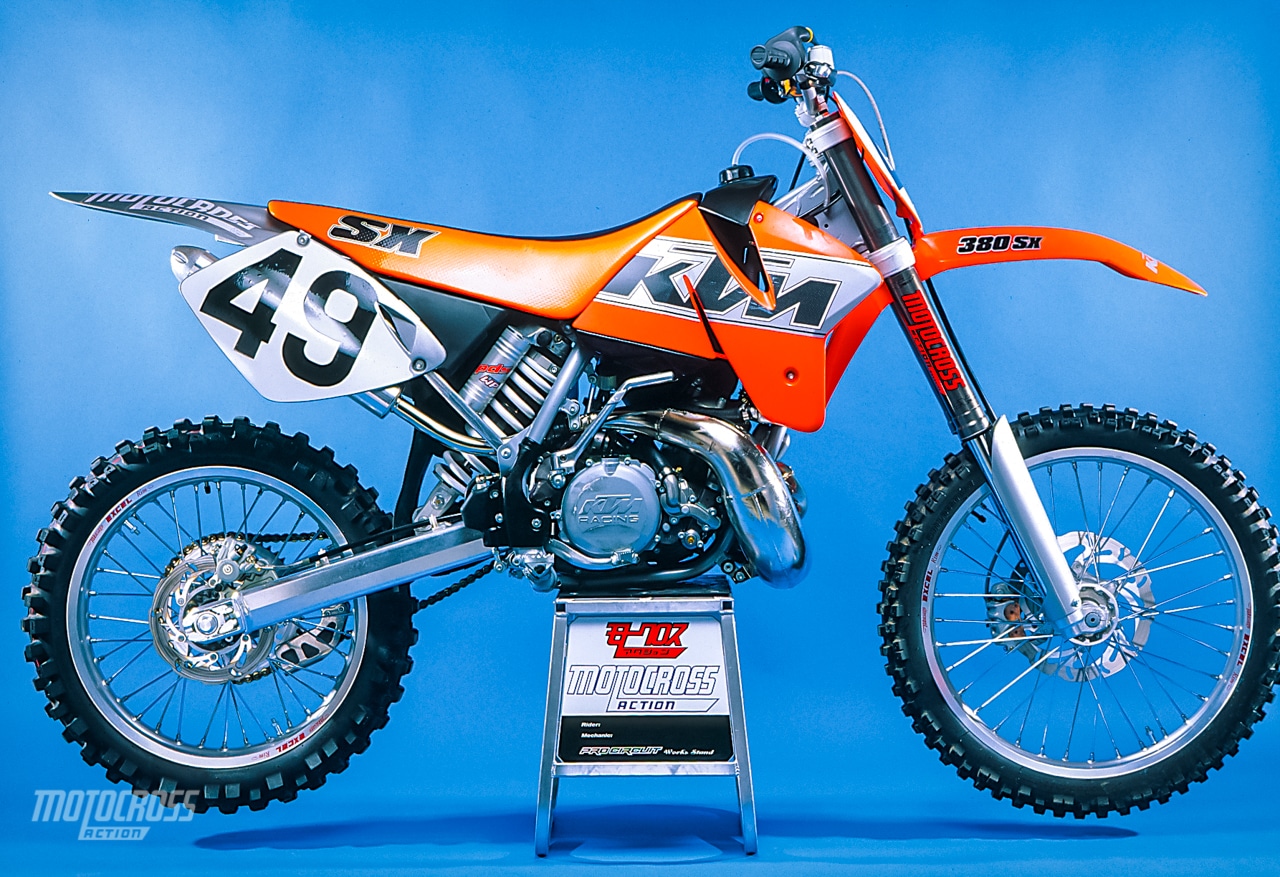 If you think that an updated version of the KTM380SX could not beat the big four-strokes, Shayne King did just that on a works version of the 380SX to win the 1996 500 World Championship.
If you think that an updated version of the KTM380SX could not beat the big four-strokes, Shayne King did just that on a works version of the 380SX to win the 1996 500 World Championship.
HOW MUCH HORSEPOWER DOES IT MAKE? In short, less than a CR500, but more than a CR250. What are the numbers? A CR500 pumps 55 horses, while CR250 tops out at 45. The KTM 380SX makes 52 ponies. That is slightly more than what a full-factory, works 250 would make.
WHAT ABOUT THE JETTING? For SoCal’s sea level tracks, we struggled with a slightly rich bottom end — which we solved by dropping the main, turning the air screw out and moving the needle clip. Here is what we ran.
Mainjet: 168 (170 stock)
Pilot jet: 45
Needle: NOZH
Clip: groove number 3
Slide: 6.0
Air screw: 2
“IF YOUR BIKE DOESN’T HAVE A HYDRAULIC CLUTCH, YOU DON’T KNOW WHAT YOU ARE MISSING. KTM DESERVES A MEDAL FOR GOING HYDRAULIC.”
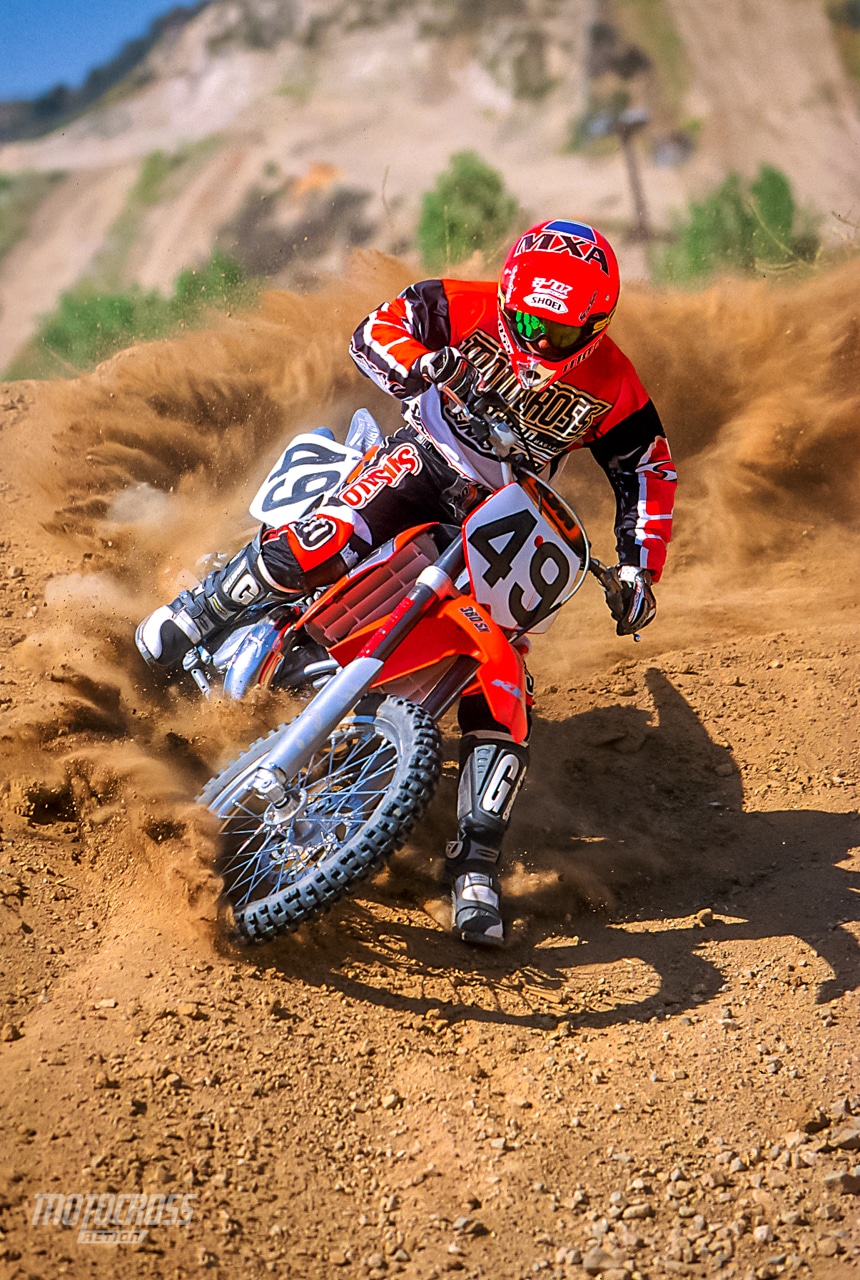 Eschewing a Power Jet carb, KTM still went high-tech with a 38mm PWK bat wing carb (also known as the Air Striker or Air Glide carb). The bat wing design first surfaced on production Kawasaki’s in 1997 ago. The jetting was off, but fixable.
Eschewing a Power Jet carb, KTM still went high-tech with a 38mm PWK bat wing carb (also known as the Air Striker or Air Glide carb). The bat wing design first surfaced on production Kawasaki’s in 1997 ago. The jetting was off, but fixable.
WHAT ABOUT THE HYDRAULIC CLUTCH? If your bike doesn’t have a hydraulic clutch, you don’t know what you are missing. KTM deserves a medal for going hydraulic. You can hammer the KTM clutch and the lever action never changes. It has a self-adjusting hydraulic mechanism that keeps lever pull constant. Sweet, very sweet.
WHAT ABOUT THE PDS REAR SUSPENSION? For a mechanical point of view there is no reason to worry about the lack of rear shock linkage. Linkage is not necessary. By positioning the shock within the known framework of a scalene triangle (one in which the sides have different lengths and angles) it is possible to duplicate the rising rate of any linkage system. The advantages of KTM’s rear suspension system are: (1) Less complexity and fewer moving parts. (2) Future rising-rate changes can be accomplished by moving the lower shock position (rather than redesigning a complicated linkage). (3) Excellent shock access. (4) The one-sided shock makes room for a straighter carburetor tract.
What are the downsides? Public opinion is that it can’t work. However, with the proper set-up it can be made to work very well. However, the proper set-up isn’t also so easy to find.
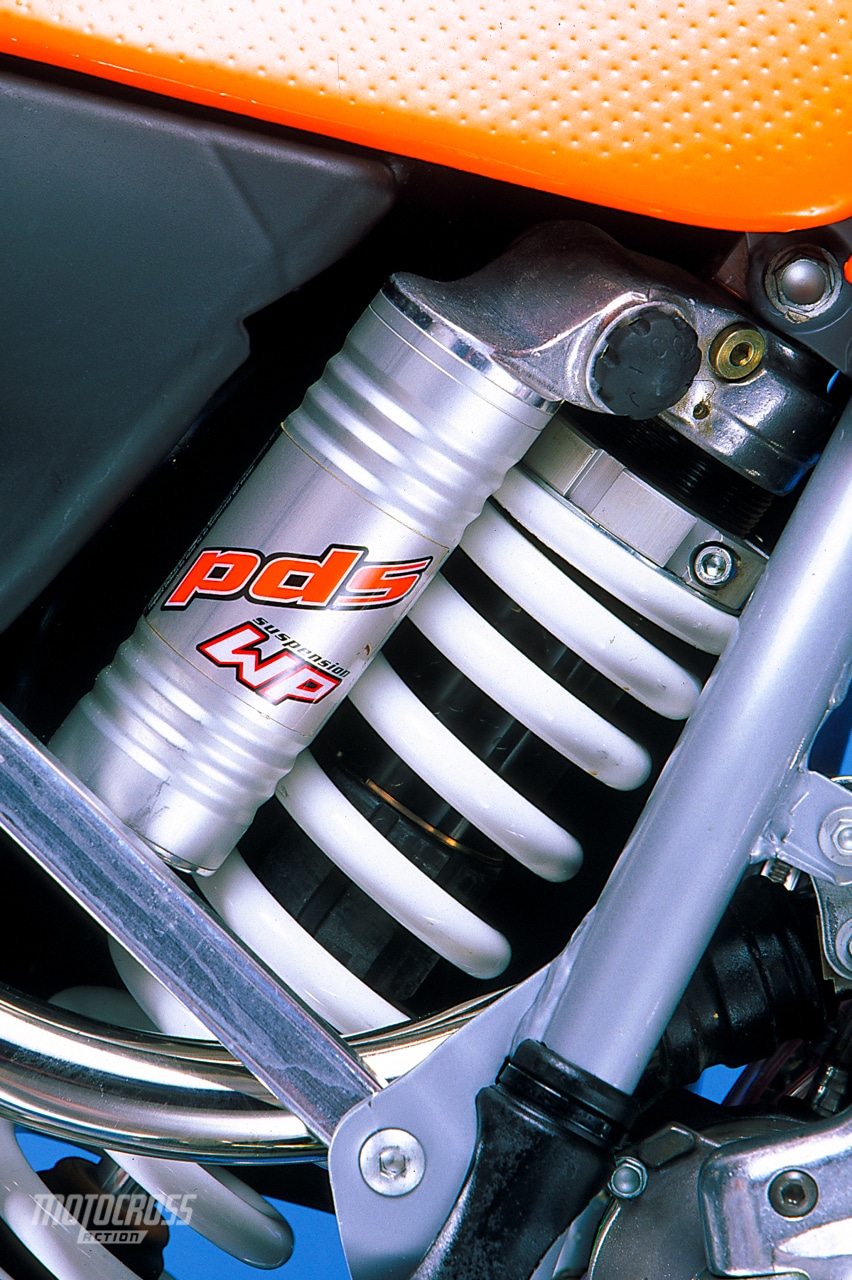 We hate progressive-rate shock springs. They don’t work. Never have. Never will. So why do manufacturers insist on putting them on their bikes. They aren’t stupid, but they were trying to make one suspension setting fit a wide range of rider’s weights, styles and sizes. Drop kick the progressive spring for a straight-rate 8.4.
We hate progressive-rate shock springs. They don’t work. Never have. Never will. So why do manufacturers insist on putting them on their bikes. They aren’t stupid, but they were trying to make one suspension setting fit a wide range of rider’s weights, styles and sizes. Drop kick the progressive spring for a straight-rate 8.4.
WHAT MAKES THE NO-LINK WORK? KTM uses its rising rate to increase shock shaft speed as the stroke progresses. This is the same actuation of any rising-rate system (linkage or not). Where KTM differs is that they use a dual-piston shock absorber (made by WP, but engineered by Ohlins). One piston is speed sensitive (to the flow of oil) and the other is position sensitive (to the location of a tapered compression needle). By combining the rising rate with a dual piston and two types of compression damping, the WP rear suspension can be supple over small bumps, progressively stiffer in whoops and firmed up enough for hard landings. The shock is outfitted with a progressive spring rate (8.3 to 10.0 kg/mm) to add more tunability.
HOW DOES PDS WORK? As we have said up to this point, KTM’s rear suspension has a lot of potential, but they always seem to be off on their settings. When it was first introduced in ‘98, the second-stage piston was cursed with a wall of damping. It literally stopped moving in mid-stroke. Last year, the engineers lessened the second piston’s spike and helped relive the PDS’ inability to flow. For 2000, they went a step further on the damping profile.
DID THEY FIX THE PDS FLAWS? Did they fix their flaws? No. The combination of a progressive rising rate, progressive dual-piston damping and progressive-rate shock spring allow the rear end to drop into its stroke and wallow around. Our quickest fix was to replaced the WP’s progressive-rate 8.3-to-10.0 kg/mm stock spring with a straight-rate 8.4 kg/mm spring. This lessened the rear suspension’s tendency to wallow, but in the end we bolted last year’s shock on the 2000 model. We liked last year’s shock better than this year’s.
WHAT WAS OUR BEST SHOCK SETTING? For hard-core racing we recommend this set-up:
Spring rate: 8.4 straight-rate (8.3/ 10.0 stock)
Race sag: 95mm
Compression: 4 clicks out
Rebound: 18 clicks out
Notes: Common sense and years of experience tell a rider that turning the compression clicker in (clockwise) will stiffen the compression damping. Not so on a KTM. You turn the clicker out for more compression and in for less. All in all, the ‘99 PDS system receives a good rating. It works best with minimal compression damping. It is possible for you boot to hit against the shock’s compression clicker and change the damping as you ride.
“WP WAS THE LAST BASTION OF CONVENTIONAL FORKS, BUT FOR MARKETING REASONS THEY HAVE THROWN IN THE TOWEL. IT’S A SHAME BECAUSE THE 1999 KTM WP FORKS WERE WINNERS. THE BEST OF ‘99.”
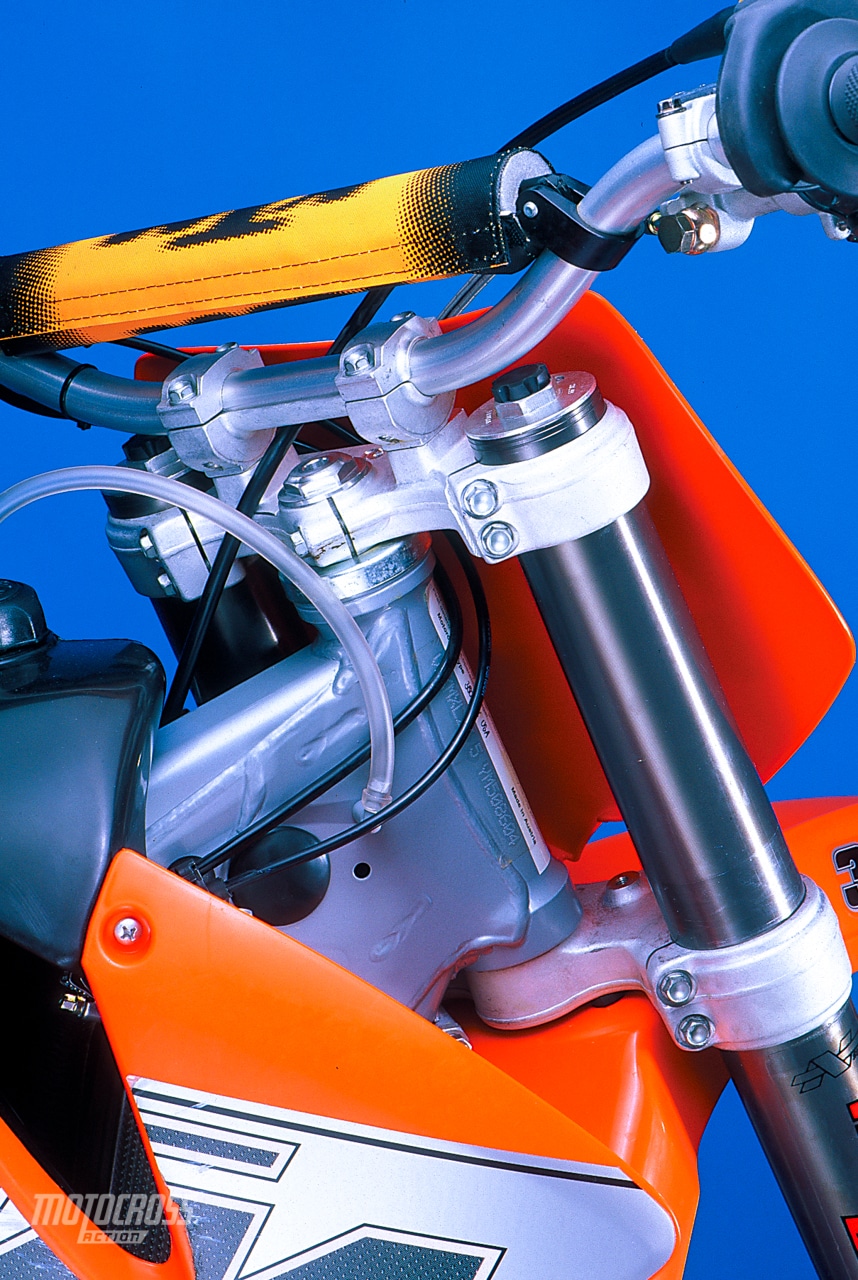 In 1999 KTM had the best forks on the track, but they couldn’t leave well enough alone. The switch from right-side-up to upside-down WP forks, while not a disaster, was not a step up.
In 1999 KTM had the best forks on the track, but they couldn’t leave well enough alone. The switch from right-side-up to upside-down WP forks, while not a disaster, was not a step up.
WHAT DO WE THINK OF THE ‘99 WP FORKS? WP (WP is the politically correct acronym for what we all know as White Power) used to be the last bastion of conventional forks, but for marketing reasons they have thrown in the towel. It’s a shame because KTM’s 50mm WP forks were winners. The best of ‘99. So what about the new upside-down WPs. Not as supple or responsive as their reverse brothers, the 2000 upside-down forks feel a little harsh on low-speed compression and too quick in the mid-stroke. They want to blow through anything larger than a medium-sized bump. The quick fix is stiffer fork springs, a slightly higher oil height and careful adjustment of the compression clicker.
WHAT WAS OUR BEST FORK SETTING? For hard-core racing we recommend this set-up:
Spring rate: 0.42 kg/mm (0.40 stock)
Oil height: 135mm (140mm stock)
Compression: 17 clicks out (14 stock)
Rebound: 12 clicks out
Fork leg height: 5mm above triple clamp
Notes: Unlike last year’s conventional forks which had way-weird adjuster placement, the new WP upside-down forks mimic Kayabas (compression on the bottom and rebound on the top).
HOW DOES IT HANDLE? KTM has been trying to lose their “Euro” handling, but isn’t easy. Their factory is in Europe. Their test riders are European, and they have a heritage of building stand-up handlers. What’s a stand-up handler? A bike that prefers to be kept upright (as opposed to laid over) in corners. If you crank a KTM into a berm, it will stand up.
As is, the KTM 380 turns surprisingly well. It’s not as quick as an RM, hooked up as a KX , stable as aYZ or accurate as a CR, but when compared to the KX500 or CR500, it is swift, agile and nimble. It likes berms, has the thrust to roost out of them and excels at power slide-style corners.
“WHAT’S A STAND-UP HANDLER? A BIKE THAT PREFERS TO BE KEPT UPRIGHT (AS OPPOSED TO LAID OVER) IN CORNERS. IF YOU CRANK A KTM INTO A BERM, IT WILL STAND UP.”
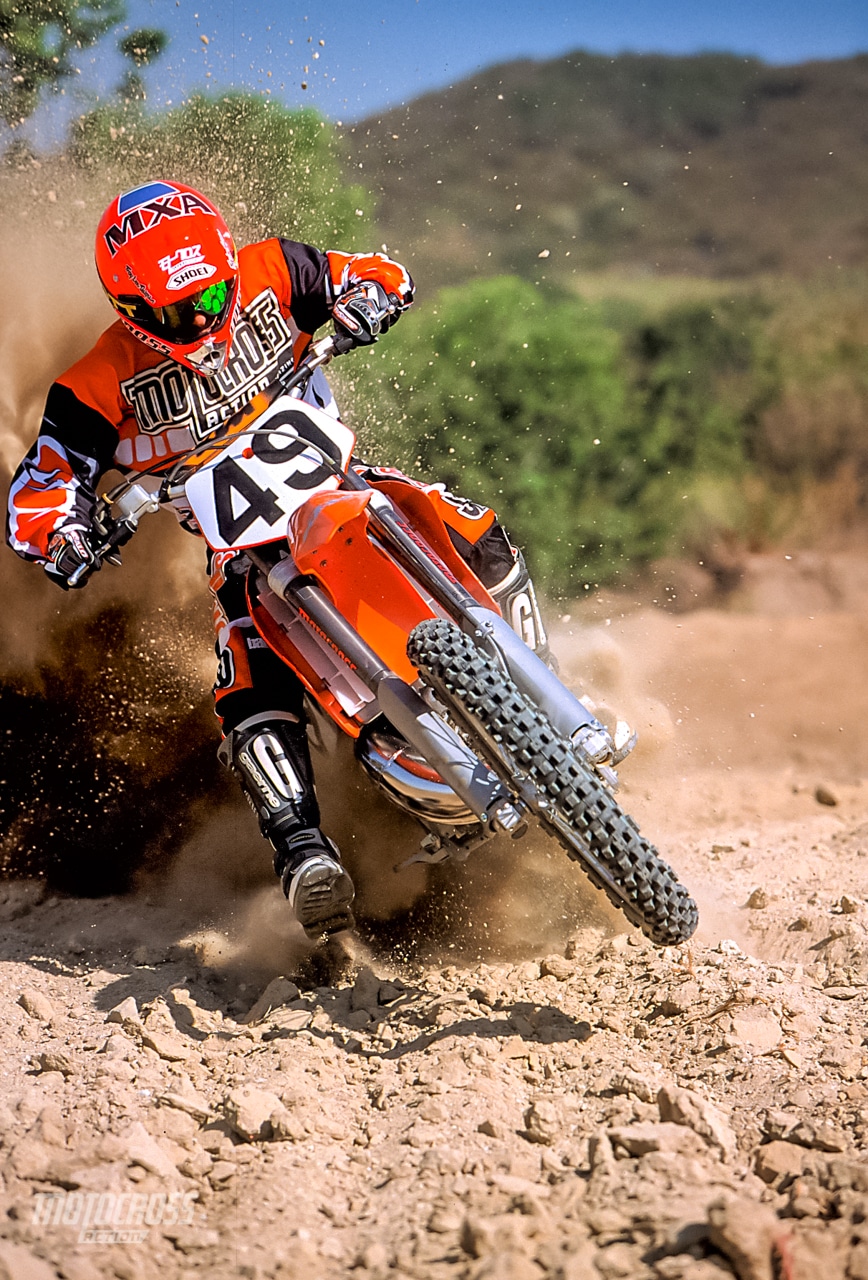 KTM dropped the 1999’s oval silencer for a very creative looking round unit. The end cap was very distinctive. Unfortunately, after we hack sawed two inches off of the muffler body the jet exhaust end cap was hidden behind the side panel.
KTM dropped the 1999’s oval silencer for a very creative looking round unit. The end cap was very distinctive. Unfortunately, after we hack sawed two inches off of the muffler body the jet exhaust end cap was hidden behind the side panel.
WHAT DID WE HATE? The hate list:
(1) Color: We have grown to like orange (and not just because it is the color of the official MXA team helmet), but we can’t get into the silver side panels, rear fender and fork guards. Please, Mr. KTM, let’s go all-orange in 2001.
(2) Front fender: Edges, creases and pleats are big in industrial design at the moment, but the KTM front fender should kill that movement. The triangular front number plate is also an eyesore, but KTM claims they designed it that way to allow more air into the radiators.
(3) Gas cap: The gas cap is too small.
(4) Radiator wings: The rear corner of the radiator wings hooks on your leathers. The quick fix is to trim the very back edge (where the seat and tank meet) so that the radiator shroud has a rounded corner.
(5) Side panels: Whoever designed the trapezoid shape of the KTM side number plates has never put a number on a bike in his life. No matter how you angle the numbers, it’s wrong.
(6) Shock bolt. Two years ago we had trouble keeping the upper shock bolt on the bike. It would loosen and fall off with regularity. Last year, we Loctited it in place and had no problems. With the 2000-model, we got complacent and lost the upper shock bolt midway through our fifth moto. Not good. Watch the shock bolt as well as you do your wallet.
WHAT DID WE LIKE? The like list:
(1) Airbox: It’s cool not to have to remove the seat to get to the filter, but in ‘99 we kept losing the dzus-style fasteners.
(2) Handlebars: The bars are aluminum. Very cool.
(3) Fork guards: Believe it or not you can take a set of Showa fork guards and bolt them on the WP forks (or vice versa). Although for the life of us we can’t figure out why we’d want to.
(4) Tires: Bridgestone M77/78s are very good intermediate terrain tires. We like this sneaker combo (although we like the rear more than the front).
(5) Frame guards: KTM and Kawasaki are the only manufacturers to include plastic frame guards to protect the paint on the tubes.
(6) Brakes: What a difference! Finally, KTM has addressed their brake problems. Thanks to a new front master cylinder, smaller diameter hydraulic line and new rotor, the front brakes are one-finger powerful. Even better, KTM put a larger piston in the rear master cylinder to cut down on hydraulic pressure in the line. The result? The brake can no longer be used to turn lights on and off. Better modulation and less lock-up are long overdue.
(7) Preload ring: We like the single preload ring on the KTM. Instead of using two rings, which lock against each other, KTM has a very thick single ring which clamps to the shock body via an Allen bolt. We throw the Allen bolt away and use an 8mm hex head bolt so that we can adjust it with a T-handle wrench.
“THERE IS NOTHING ELSE LIKE IT ON THE TRACK. MORE POWER THAN A 250, LESS THAN A 500 AND MORE SNAP THAN A YZ400.”
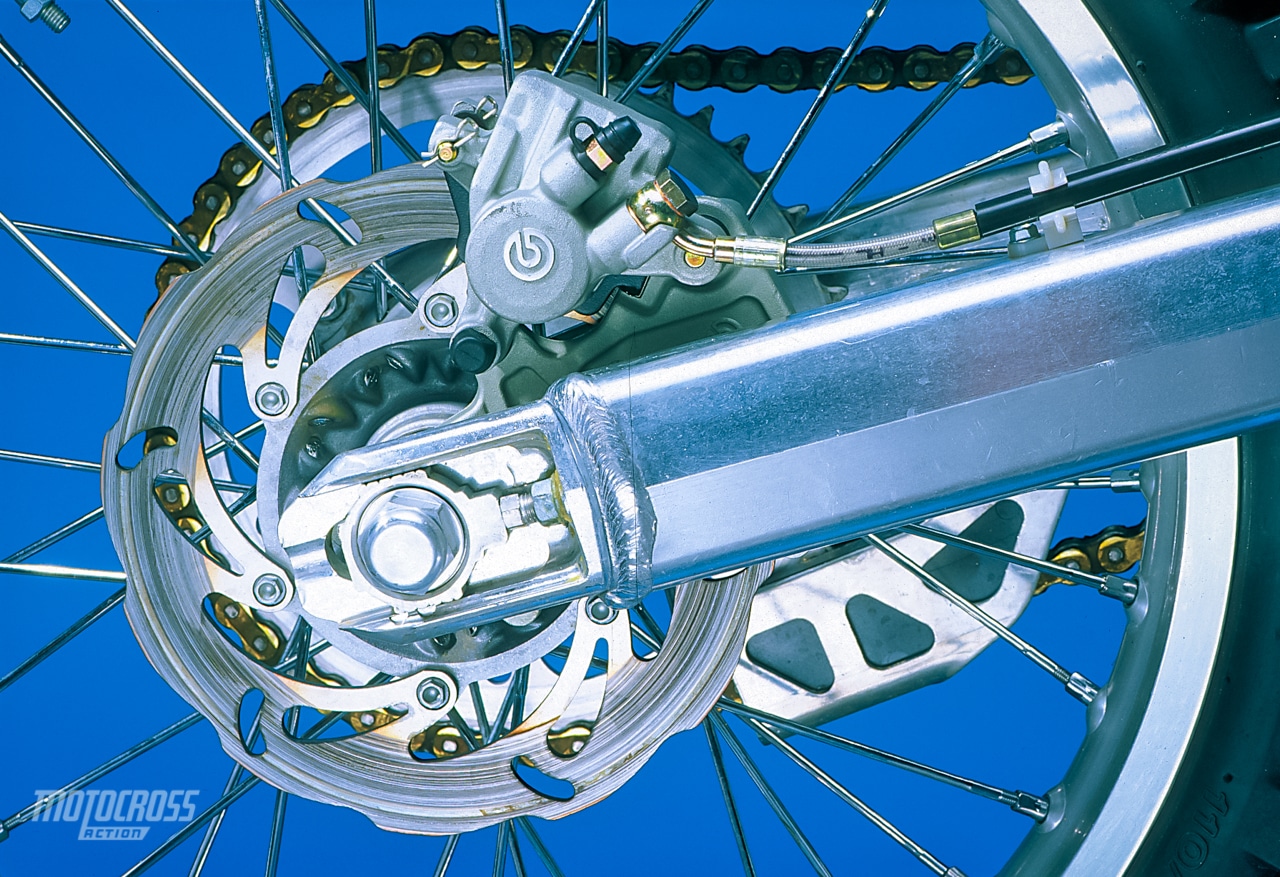 KTM claimed that the macrame brake rotor was self cleaning, but in truth the notched disc was designed to equalize surface area between the upper edge of the brake pads and lower edge. Say what? The top of the rotor travels farther than the bottom.
KTM claimed that the macrame brake rotor was self cleaning, but in truth the notched disc was designed to equalize surface area between the upper edge of the brake pads and lower edge. Say what? The top of the rotor travels farther than the bottom.
WHAT DO WE REALLY THINK? Let’s review.
Engine: There is nothing else like it on the track. More power than a 250, less than a 500 and more snap than a YZ400. If you want more power, but don’t want the weight of a full 500, this is your mill. However, if we had our druthers, we’d choose the 1999 powerband over the 2000. It’s a better motocross engine.
Handling: Once you get over the Euro-feel, the KTM begins to shine. Chassis set-up is middle of the road, but that insures that the Katoom does very little wrong.
Suspension: Last year’s suspension was better. Hands down. The new upside-down forks and revalved shock aren’t atrocious, but they need some help — help that they didn’t need last year.
Overall rating: We admit that in this day of diminishing Open class turnouts, a mid-sized bike isn’t for everyone. But, it makes an incredible Vet class racer. The only Open two-stroke that is better than the 2000 KTM 380SX is the 1999 380SX.







Comments are closed.